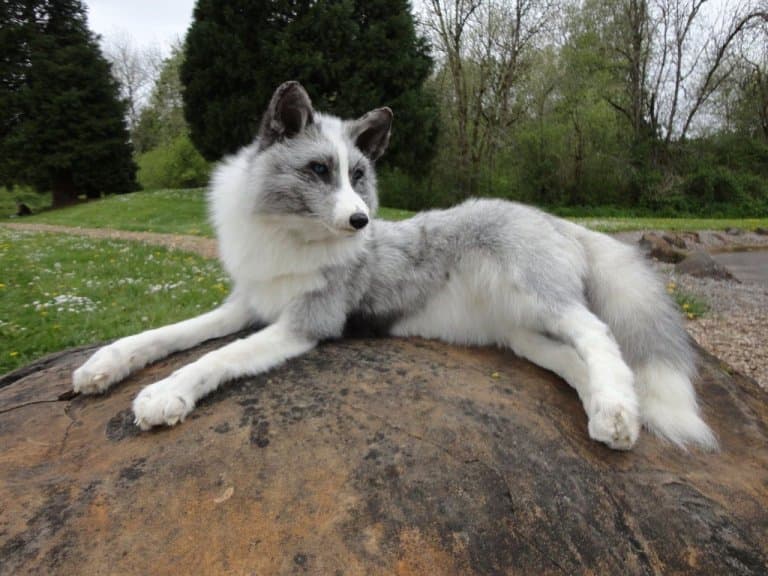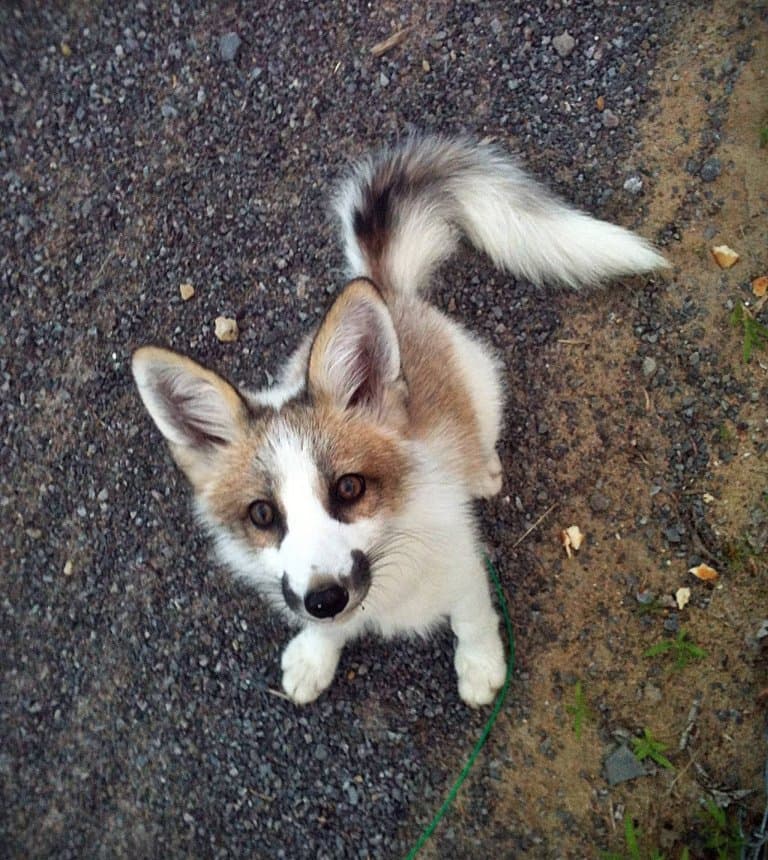Canadian Marble Fox Profile
An unusual animal is being passed around the internet with so much mystery surrounding it that many believe it doesn’t even exist.
And if you try to look into it, sifting through the conflicting information, impossible lies and photos of totally unrelated animals claiming to be of this creature do a good job of persuading you this is a hoax.
But the Canadian marble fox is real. It’s not what most people are saying it is, but it does exist.

Canadian Marble Fox Facts Overview
| Habitat: | Captivity |
| Location: | Across the Northern Hemisphere |
| Lifespan: | 10 years |
| Size: | Around 70cm (27 inches) long |
| Weight: | Up to 9kg (21lb) |
| Colour: | White with marble grey markings |
| Diet: | Omnivorous |
| Predators: | Dogs, coyotes, wolves, humans |
| Top Speed: | Unknown |
| No. of Species: | Not a species |
| Conservation Status: | Not listed |
The Canadian Marble fox is a color morph of the common red fox, Vulpes vulpes.
It seems to have come from a melanistic version known as the Silver fox, which is a rare, dark mutant, favoured for its fur in the 1940s.
A lot of selective breeding has gone into making them, so they’ve become domestic-looking, but they’re still fox-like when it comes to looking after them.
Smart, agile and destructive. So they make terrible pets!
Interesting Canadian Marble Fox Facts
1. They’re probably Norwegian
Marble foxes aren’t a particular species of fox, they’re simply regular old red foxes, Vulpes vulpes; just like the kind you’d find in your bins.
In some cases, they may be selectively bred for their coloration, though as a mutation, it can potentially happen naturally.
They’re selectively bred for their white and dappled coats, possibly with a melanistic variety of red fox known as a silver fox, which has a darker coat.
This dark coat is thanks to a similar mutation to the one that makes some leopards black, and this is why panthers are not a separate species from leopards (or jaguars).
It’s hard to be sure, but it appears that the first marble foxes were recorded in Norway, having been bred to be farmed for their unique fur. It’s said that the first marble fox was born to a silver fox litter in 1945. 1

2. What it isn’t
This animal is one of the most misrepresented on the internet. There’s so little reliable information and plenty of entirely false claims. Here are a few:
- Despite the name, these are a different species than the Arctic fox, which is Vulpes lagopus, and not related.
- It’s also commonly referred to as a hybrid, which isn’t accurate because both of its parents are the same species.
- Some sources change the species name halfway through the article, some use photos of what is clearly a breed of dog, and there are people on Facebook passing around a photo of a fluffy toy and claiming that’s a marble fox.
- One video suggests there are only a few thousand left in the wild, and they’re important to the ecosystem and an endangered species; none of which is true. While there were breeders in Canada, there’s nothing natively Canadian about this fox.
One thing that should be emphasised is that these are not good pet animals. They’re very much a Red fox, and while they’ve technically been domesticated, this is not the same thing as pet-ready.
As such they’re not particularly easy to look after, despite being a popular choice for exotic pet fans.
3. Their coloration is a product of domestication
Like the border collie and various species of farm animals, marble foxes have a colour pattern that isn’t found in the wild. They also have floppy ears and reduced skull size over their wild equivalent, all traits that seem to come with the territory when animals are selectively domesticated.
This strange outcome is known as “Domestication Syndrome” and it’s a focus of many studies to figure out why, how, and even if it’s a real thing that happens.
Foxes in fur farms are the inspiration for the study of this principle and have been the inspiration for numerous genetics experiments to try and fully understand how selecting for one trait in a breed brings with it others.
Marble foxes have been bred for “tameness” and have carried other classic domestication traits along with them, but being good in the house isn’t one of them. 2
4. They don’t make good pets!
Despite technically being domesticated, they’re not easy. Even zoos have a hard time working with foxes. They’re high energy, noisy little canids, and crafty, to boot.
They need a lot of care and attention and while they will bond with people easily, they can be a lot to handle. They’re destructive animals that need specialised habitats to be allowed to express themselves.
They also stink. Fox urine and faeces are some of the least fun things to have in your garden, and bringing foxes into the house for any prolonged period is a recipe for worse.
These foxes have not been bred for trainability, and while they may be more friendly than their wild equivalents, they are resistant to house training.
Another issue of keeping foxes as pets is finding qualified vet care for them.
5. They’re mostly illegal
Because of all of this, and the fact that Vilpes vulpes is a wild animal species, in many countries and several states of the US, owning marble foxes as pets is forbidden without a special licence.
However, there are still many places where there’s no law against owning a pet red fox, and some people do have them.
Marble foxes have been picked up by sanctuaries when owners realise they can’t handle them. 3
Canadian Marble Fox Fact-File Summary
Scientific Classification
| Kingdom: | Animalia |
| Phylum: | Chordata |
| Class: | Mammalia |
| Order: | Carnivora |
| Family: | Canidae |
Fact Sources & References
- Norodd Nes (2009), “The Genetic Factors for Colour Types in Ranch Bred Foxes”, Taylor & Francis Online.
- Kathryn A. Lord (2019), “The History of Farm Foxes Undermines the Animal Domestication Syndrome”, Trends in Ecology & Evolution.
- Black Pine Animal Sanctuary, “Black Pine Animal Sanctuary”, Facebook.
